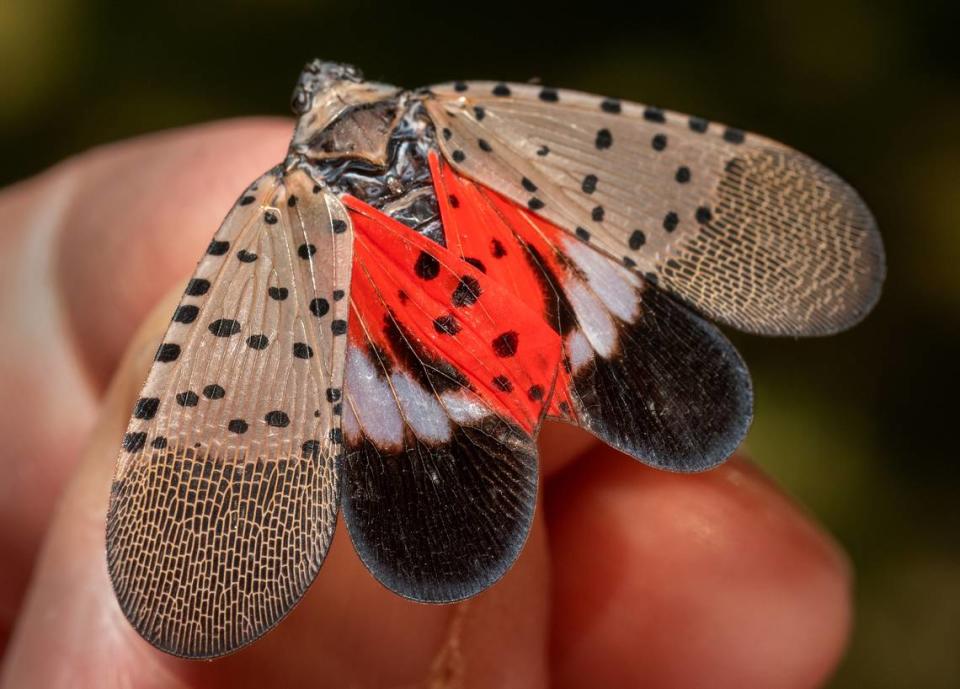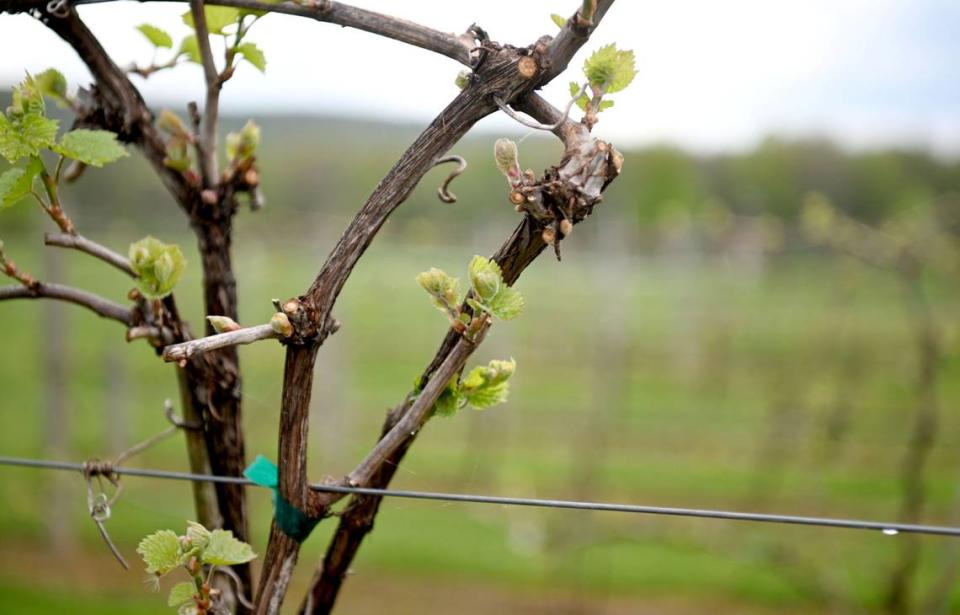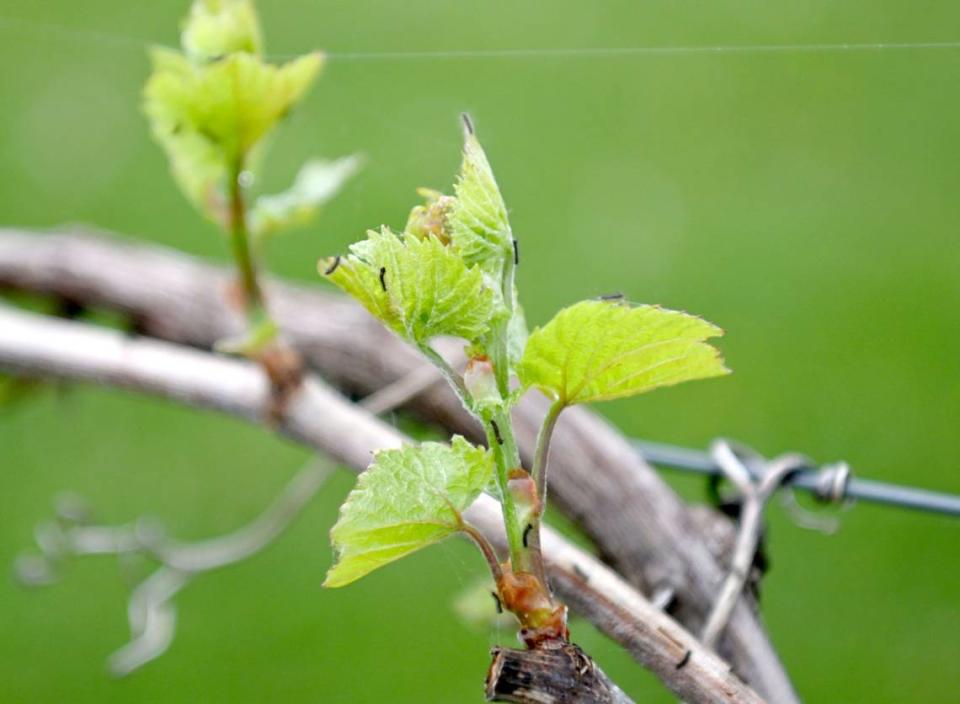Spotted lanternflies pose a major threat to vineyards. Centre County wineries are on alert
Grape growers beware: The spotted lanternfly might increase in prevalence this summer in Centre County. Though the invasive leafhopper from Asia is most known to be a nuisance and not a destructive force to trees and plants, it can have a damaging effect on Happy Valley’s vineyards if a large population takes hold this season, according to experts.
Last summer, Centre County residents reported seeing spotted lanternflies 529 times, according to data from the Pennsylvania Department of Agriculture. That is a more than 500% increase from summer 2022, when residents reported seeing the invasive pest 79 times, and about a 1000% increase from 2021, when residents reported 44 sightings.
The PDA added Centre County to its quarantine zone in 2022, which regulates the movement of vehicles that may harbor the insect. Introduced to North America in Berks County in 2014, the lanternfly is a notorious hitchhiker on cars, boats and trucks moving across highways. In 2024, all but Pennsylvania’s 15 northernmost counties were included in the quarantine.
A spotted lanternfly infestation is noticed immediately, noted Brian Walsh, Penn State Extension educator and spotted lanternfly researcher. Adult lanternflies collide into people, typically at eye level, and swarm neighborhood trees and outdoor events. They also secrete honeydew, a euphemism for liquid excrement, that can then grow a type of black sooty mold that stains patios and furniture.
But the nuisance issue — hundreds or thousands of inch-long bugs that are seemingly crawling over everything, Walsh said — is not his greatest concern.
“When the lanternfly first got here, there was a lot of fear it would be attacking our hardwood forests,” Walsh said. “We understand a lot more now — we’re just about 10 years since discovery — and we recognize now that the biggest threat in agriculture is the grape industry. Most businesses will be able to weather it, but grape growers can actually lose vineyards if they don’t respond appropriately to the invasion.”

The hardwood trees can take a number of years of attack, according to Walsh, and not be killed outright, while grape vines typically cannot withstand heavy feeding from lanternflies from a single season.
“From what we’ve seen so far, it typically takes two to three consecutive years to reach a high population of lanternflies in a vineyard,” said Michela Centinari, associate professor of viticulture at Penn State. “It’s not something that happens overnight. It’s very hard to predict how the lanternflies behave, but we know that grapevines are one of their favorite haunts. We expect there to be more lanternflies around vineyards this year, around Centre County and other areas of the state.”
A learning curve for grape growers
Experts have seen over time, in Berks County, Philadelphia and elsewhere, that lanternfly populations increase for three to five years, reach a peak, then fall off. That aligns with the time period it would take for a large population to destroy a vineyard.
Spotted lanternflies are phloem-feeders, Centinari said, meaning they feed upon the sap in the stem and trunk of the vine, not the leaves or the fruit.
“You don’t see immediate damage in the grapevines, unlike chewing insects or insects that feed on fruit, where you can see where they are attacking the plant,” Centinari said. “It’s very hard to see the damage while the lanternflies are attacking a plant, but the year after a large infestation, we see dead vines in vineyards.”
Centinari said that managing an infestation is a learning curve for grape growers, especially close to harvest time. The nymph stage of the lanternfly life cycle, which occurs early on in a growing season in May, is not as great of a concern for vineyards as the adult stage, in September and October.

“There can be thousands of adult lanternflies that all arrive around harvest time, when it’s more difficult to know when to spray insecticide to avoid spraying on the fruit,” Centinari said.
Gene Proch, owner of the University Wine Company in Harris Township, said that though he has not yet had any vineyard damage from the spotted lanternfly, he saw around 100 adult lanternflies on the property around his winery’s building last year.
“The question is, the adult flies I saw on the property at the end of the summer, have they made it and laid eggs somewhere?” Proch said. “I don’t know, but we will be on the lookout this spring and early summer for nymphs in the vineyard, because they really do attack grapevines.”
Proch said he is concerned with spongy moths, formerly known as gypsy moths, which he thinks will be a greater issue this year for Happy Valley than the spotted lanternfly. Spongy moth caterpillars attack tender leaves and destroy trees and plants, including grape vines.

Patton Township sprayed 1,285 acres last May across the Valley Vista, Park Forest, Homestead Farms, Oakwood and Woodycrest neighborhoods to control spongy moth caterpillars, and plans to spray again this year in late May or early June.
“Last year, we had gypsy moths floating into the vineyard on their threads, and on Tussey Mountain behind us, you can see brown spots already, so I suspect this year will be worse for defoliation,” Proch said. “I’m sure they will do the same thing to the vineyard if they get into grape vines.”
On the lookout
Doug Rogers, winemaker at Happy Valley Winery in Ferguson Township, said that he, too, observed about 100 adult lanternflies around the winery buildings last year, but none in the vineyard.
“We searched around for egg masses in late summer and early fall, but we did not find egg masses where we found the adults,” Rogers said. “I’m hopeful we don’t have an outbreak this year.”
Rogers said that every spring, he works to reduce the potential for fungi and disease by burning the debris that comes off with pruning, and in doing so, he might have burned off egg masses that he did not notice.
“All we can do is keep an eye out to catch them at an early stage, and if we do see them, monitor the situation and figure out what the best next step is,” he said.
Scott Hilliker, winemaker at Mount Nittany Vineyard & Winery in Harris Township, said he did not see any spotted lanternflies last year, but he put posters up around the winery to have customers keep an eye out. His vineyard staff also is trained to proactively look for them.
“I know they’re in Centre County, and that it’s just a matter of time before they find us on this side of the mountain,” Hilliker said. “We’ve been fortunate so far, as we do get a lot of traffic coming in from other parts of PA, and they can travel, hitch onto cars and fly out. We try to be aware of what’s going on and do a good job of educating customers and employees.”
It is difficult to quantify populations of spotted lanternflies, according to Walsh, as they are millions of moving targets that utilize many different host plants. Experts still do not know how far an individual adult lanternfly can fly in a season before laying eggs and dying.
One of the ways that experts currently track populations is through citizen reports, though they are not an exact science.
“While citizen reports can help officials respond quickly to new infestations, they can anecdotally be used to know where hot spots are, such as in Allegheny County last year,” Walsh said. “What we don’t know is what the fall off rate of reporting is in subsequent years, and we think it’s significant, not because lanternflies are not present but more from a ‘fatigue’ with the pest.”
Centre County residents can report lanternfly sightings this season to the PDA online or by calling 1-888-4BAD-FLY (1-888-422-3359).

